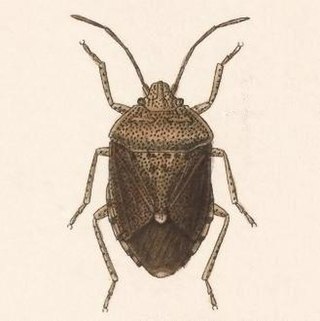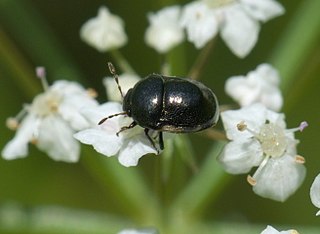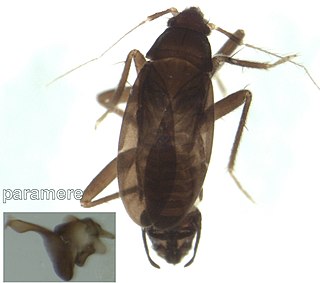
Anthocoridae is a family of bugs, commonly called minute pirate bugs or flower bugs. Worldwide there are 500-600 species.

Ploiaria is a cosmopolitan genus of thread-legged bugs (Emesinae). There are presently about 130 described species.

Emesopsis is a genus of tropical bugs (Heteroptera) from the family Reduviidae. There are at least 22 described species, of which one, E. nubila, also occurs in southern Europe.

Empicoris is a cosmopolitan genus of thread-legged bug (Emesinae). Numerous species have been described.

The Thyreocoridae are a family of shield bugs, known by common names that include negro bugs or ebony bugs. Historically, a few authors have called this family "Corimelaenidae" (e.g.), but the name Thyreocoridae, published in 1843, has nomenclatural priority over Corimelaenidae, published in 1872. Other classifications have placed them as a subfamily within the broad family Cydnidae.

Oncerotrachelus is a genus of assassin bugs in the family Reduviidae. There are about 14 described species in Oncerotrachelus.

Mezira is a genus of flat bugs in the family Aradidae. There are more than 70 described species in Mezira.

Cydamus is a genus of broad-headed bugs in the family Alydidae, found in the Americas. There are about 15 described species in Cydamus.

Thyanta is a genus of stink bugs in the family Pentatomidae. There are about 19 described species in Thyanta.
Galgupha nitiduloides is a species of ebony bug in the family Thyreocoridae. It is found in Central America and North America.

Lopidea is a genus of plant bugs in the family Miridae. There are more than 90 described species in Lopidea.
Isthmocoris is a genus of big-eyed bugs in the family Geocoridae. There are at least four described species in Isthmocoris.
Crophius is a genus of true bugs in the family Oxycarenidae. There are about 16 described species in Crophius.

Trichopepla is a genus of stink bugs in the family Pentatomidae. There are about six described species in Trichopepla.

Mozena is a genus of leaf-footed bugs in the family Coreidae. There are more than 30 described species in Mozena.

Corimelaena is a genus of bugs in the family Thyreocoridae. There are at least 20 described species in Corimelaena.
Corixidea is a genus of jumping soil bugs in the family Schizopteridae. There are at least three described species in Corixidea.
Megalopsallus is a genus of plant bugs in the family Miridae. There are at least 30 described species in Megalopsallus.

Ceratocombus is a genus of litter bugs in the family Ceratocombidae. There are about nine described species in Ceratocombus.
Canopus is a genus of Neotropical bugs with about six species that form the family Canopidae. Bugs in the family Canopidae are small and have a convex lady-bird beetle like shape and are thought to be fungus feeders. The scutellum completely covers the abdomen and wings. The antennae are five segmented.













